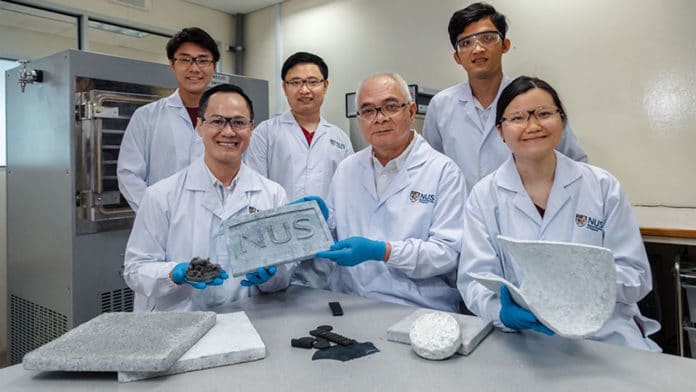NUS scientists have developed super-light aerogels with new properties such as lightweight, highly absorbent, very durable, and highly efficient at trapping heat and sound. They have developed the aerogels from waste rubber tyres that promote wider use of scrap tires and offers an eco-friendly way to recycle used rubber.
Associate Professor Duong Hai-Minh, who leads the research team from the Department of Mechanical Engineering at NUS Engineering said, “Although 40 percent of waste rubber tires are recycled, the rate of recycling worldwide remains low because processing used rubber is costly and energy-intensive, coupled with a lack of monetary incentive. Our team has decided to focus on creating rubber aerogels from used rubber tyres because they are a cheap and abundant source of raw materials. By converting waste rubber tyres into high-value aerogels, we could enhance the monetary incentive for recycling rubber and, in turn, cut down rubber waste.”
Mr. Edmund Cheng, Mapletree Chairman, said, “Mapletree has always placed great emphasis on integrating sustainable designs into our developments. This project, which aims to turn rubber waste into aerogel materials via green technology, is aligned to our commitment to reducing negative environmental impact. We are excited that part of the support will also fund the refurbished lab facility for applied research and education on the potential of recycling technology. We hope that through education, one of our key corporate social responsibility pillars, there will be more aware of environmental issues.”
Scientists started with recycling car tyre fibers that are then soaked in water and a minimal amount of chemical cross-linkers. Next, the mixture of rubber fibers and eco-friendly solvents is dispersed uniformly using a stirrer for 20 minutes. The smooth suspension gel is then freeze-dried at minus 50 degrees Celsius for up to 12 hours to produce rubber aerogels.
Assoc Prof Duong said, “The fabrication process is simple, cost-effective and eco-friendly. The entire production process takes between 12 to 13 hours to complete, and it only cost less than S$10 to produce a sheet of rubber aerogel that is one sqm in size and 1cm thick. The process can also be easily scaled up for mass production. This makes rubber aerogels a commercially attractive product.”
This novel technology was published in the print version of scientific journal Colloids and Surfaces A: Physicochemical and Engineering Aspects in September 2019, and a patent has been filed.
